Tuesday 22nd February to Friday 4th March 2022
Uligan, where we first arrived after our 1500 mile passage from Thailand, is in the most northerly of the 26 atolls which make up the Maldives. It is also one of only three places where yachts can check in and out of the country.
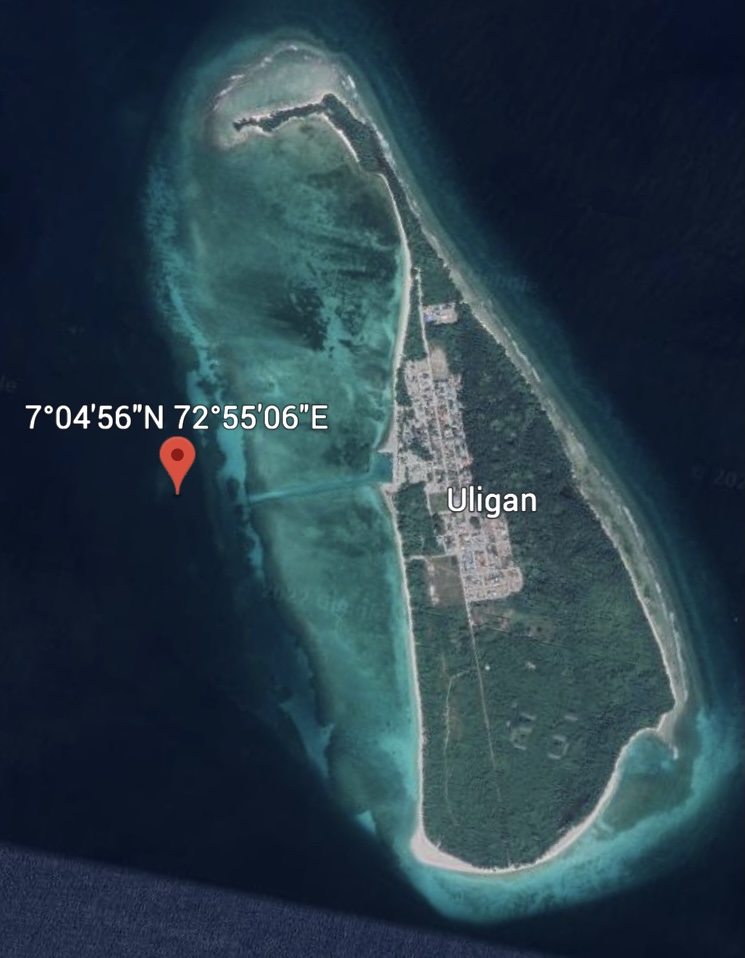
After the visit to Vega by Customs, Immigration and Asadhulla (Assad), our agent, we sorted out the chaos onboard and checked emails. We were relieved to get the results of the histology from the squamous cell carcinoma that Hugh had removed in Phuket before we left, which showed it had been completely excised. In the early evening we headed over to Uligan village in the dinghy, through the boat pass in the surrounding reef. We had been warned to wear face masks as six people in the village had recently tested positive for Covid and were isolating. I had enquired about dress code and was told that thighs and shoulders should be covered but long shorts would be ok.
Although there are over 400 people living on the island, it was very quiet ashore with hardly anyone to be seen. We passed the modern customs building and found the small café where we met up with Assad, our friend Jon on Hecla, and the sailors from the three other yachts at anchor here, who were all stopping for a few days before continuing on via the Red Sea and Suez Canal to the Med. They were two British singlehanded men and an American/Finnish couple, all in smallish monohulls. The Maldives is a Muslim country so no alcohol was served in the café but the virgin mojitos and the lime juice were excellent. The café became the focal point of our meetings, serving simple meals of chicken or tuna with rice or noodles. The local men also meet here to socialise but we only once saw any local women in the cafe, two from the committee to promote female equality on the island.
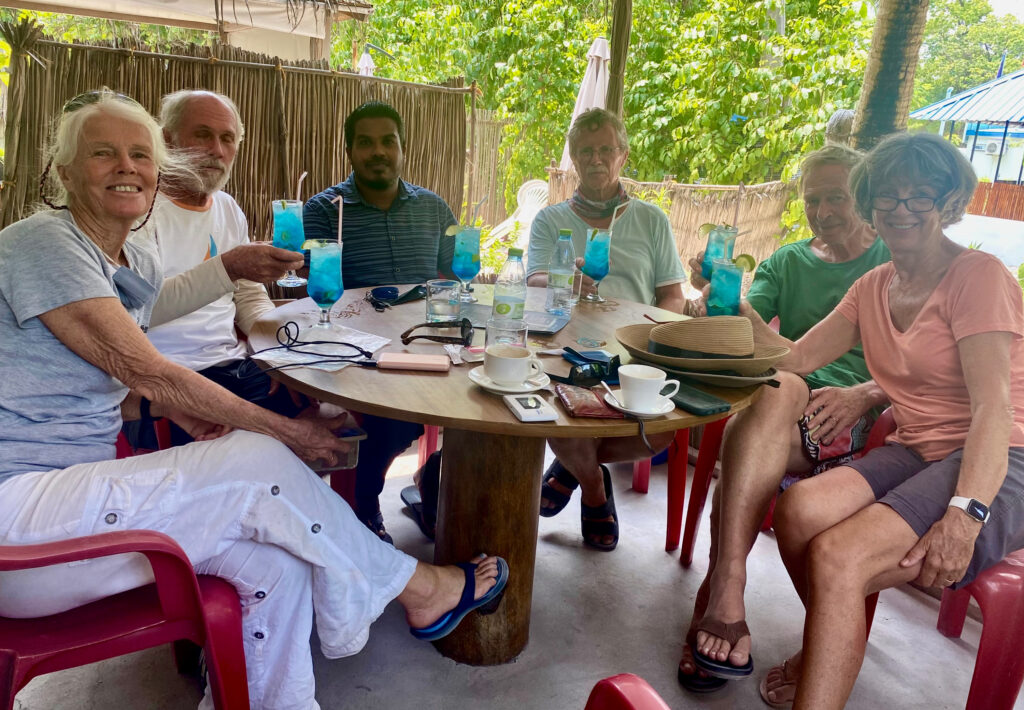
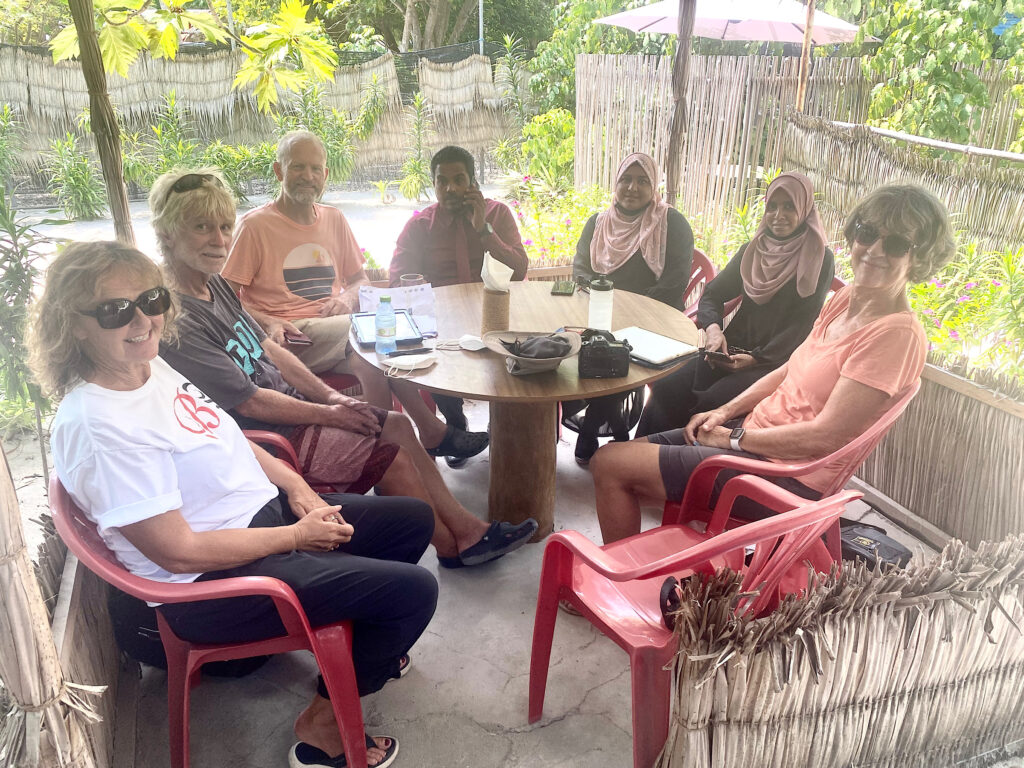
Uligan is a long, thin island, 1.6 miles long and only half a mile wide. There is the small village in the middle, all hot sandy streets which seemed practically deserted whenever we were there. Wandering around there are the high, grey, windowless outside walls of the village houses and courtyards which are mainly built using coral rock or breeze blocks, three small supermarkets and a bakery, a school, two mosques, a health clinic and pharmacy, and the one cafe. Some people buzz around on scooters, there are no cars. The local women, covered head to toe usually in black, will acknowledge you if directly addressed but mostly ignored us. The call to prayer is transmitted from loudspeakers from the mosques five times a day… before dawn at about 5am through to dusk, at about 6.30pm. It’s not at all what you imagine when you think of the Maldives.
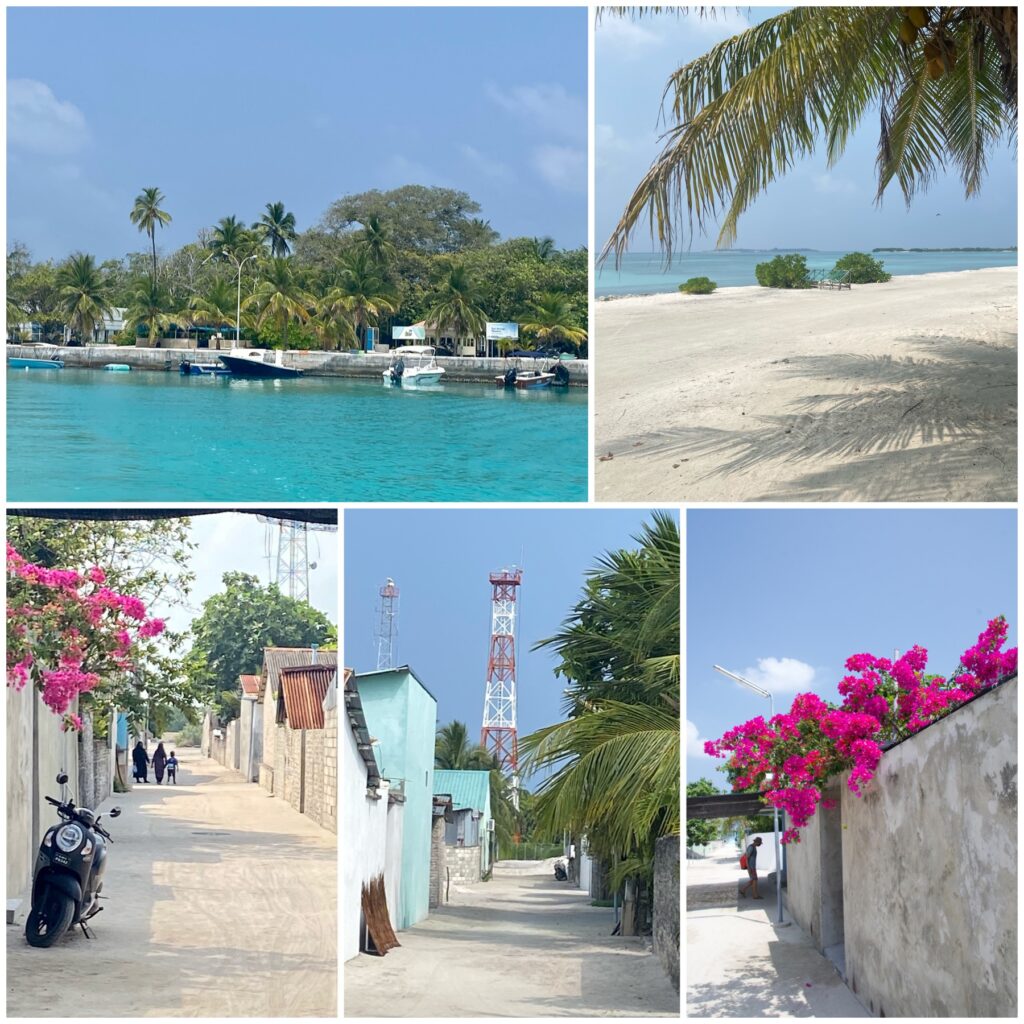
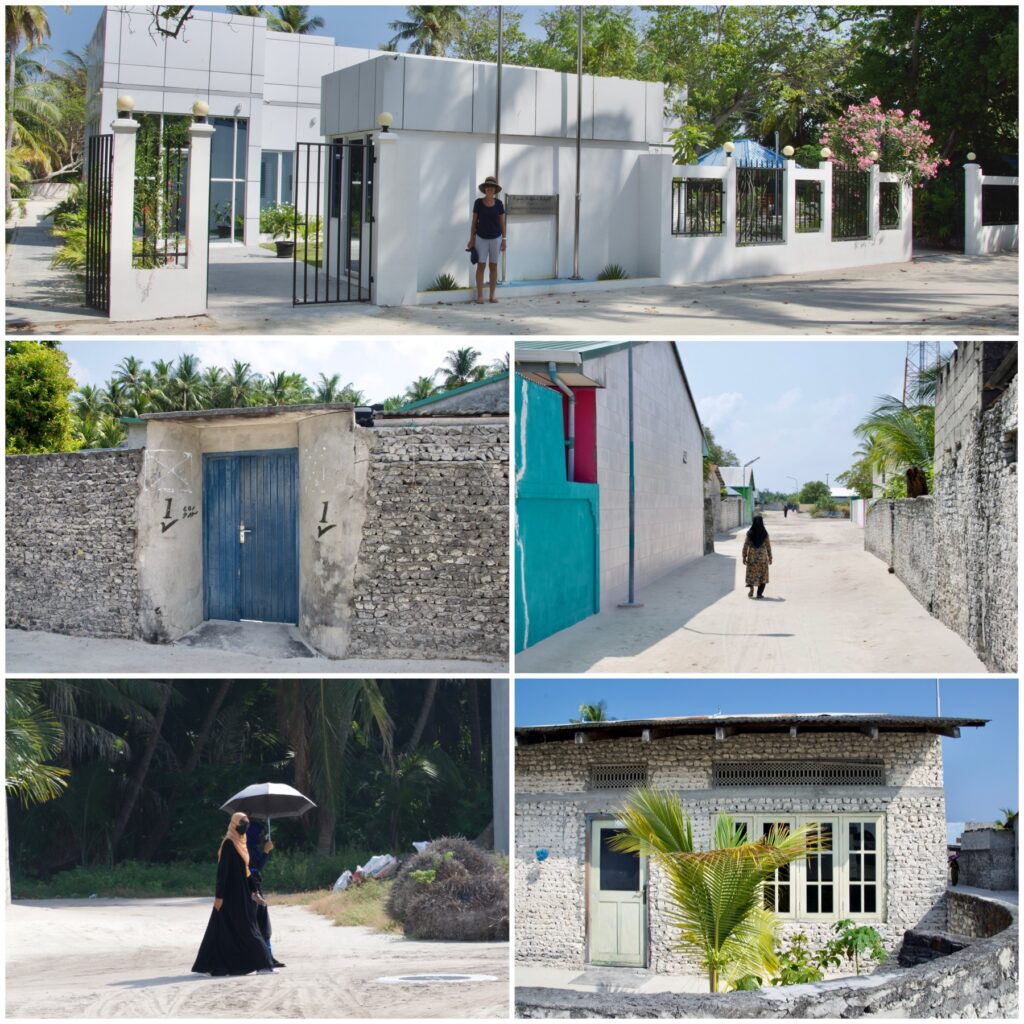
We went for several walks around the island. To the north is a wind farm which has fallen into disuse. We passed the school which was closed as it was a Friday, a weekend day for the Maldivians. 77 children attend the school and there are 32 teachers, mostly women, all of whom have masters degrees. I asked whether we might visit but there was a reluctance in view of Covid.
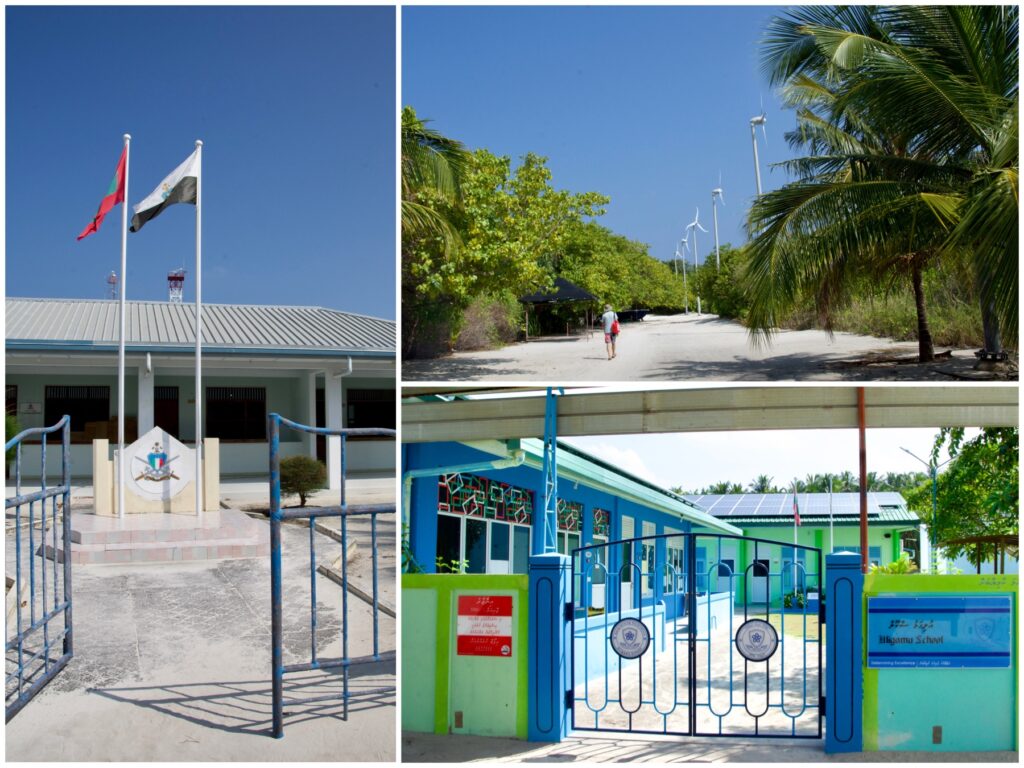
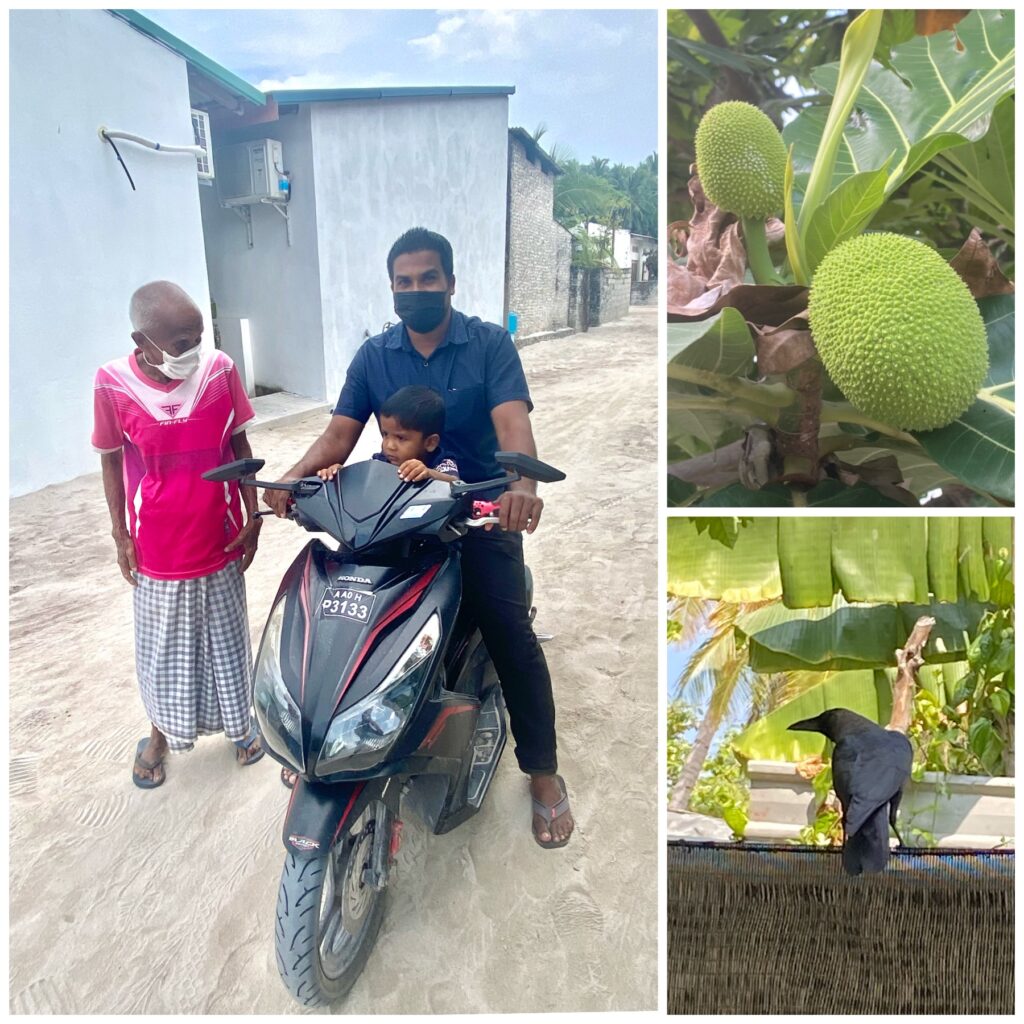
South of the village, along a hot, sandy path there were some vegetable gardens, screened off against fruit bats, but peering through the netting there didn’t seem to be much growing apart from some small green peppers. Most food is imported to the Maldives and the supply boat which brings fresh fruit and vegetables to Uligan comes less than weekly, so you need to get to the shop quickly before it has sold out. In the supermarket there was a reasonable selection of goods. The eggs come from India and are usually several weeks old. They are small and white and the shopkeeper shines a torch through each one looking for dark shadows.
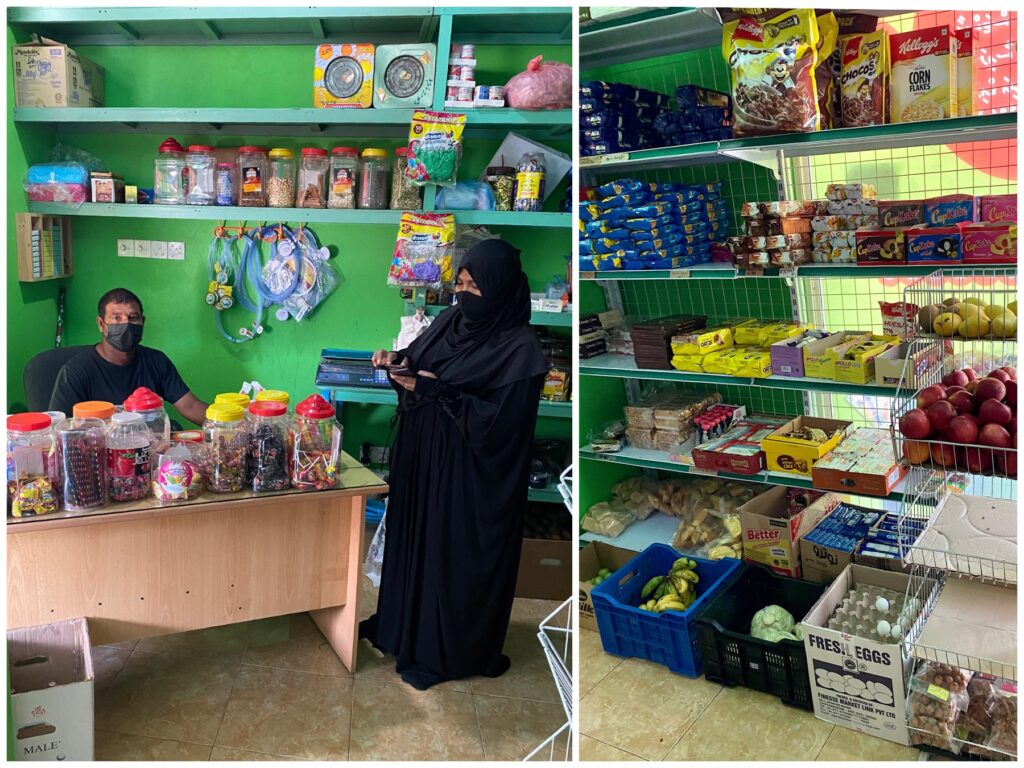
We saw breadfruit and papaya trees growing in courtyards and most of the courtyards had large water tanks to catch and store rainwater. Enough rain will fall during the rainy season of May to November to last through the dry season. There is also a freshwater well near the harbour which is not fit for drinking. Increasingly people use bottled water for drinking.
Although the streets are very clean, to the east of the village is a large shady area of tropical forest with densely planted palm trees, which appears to be the village rubbish dump. It was shocking to see how much plastic and abandoned trash was strewn all over the ground. We had been told to leave our bagged up rubbish in a collection area and it would be taken off the island, with aluminium separately bagged for recycling. It is hard to know how these islands can deal with the problem of single use plastic, with their relatively small land mass. There are initiatives in place to reduce it or even to ban it completely, but there are no state-managed recycling facilities in the country, much of the waste is burnt causing toxic gases, and we are automatically handed plastic bottles of water and plastic straws with our drinks in the café, and plastic bags in the supermarket (we, of course, bring our own).
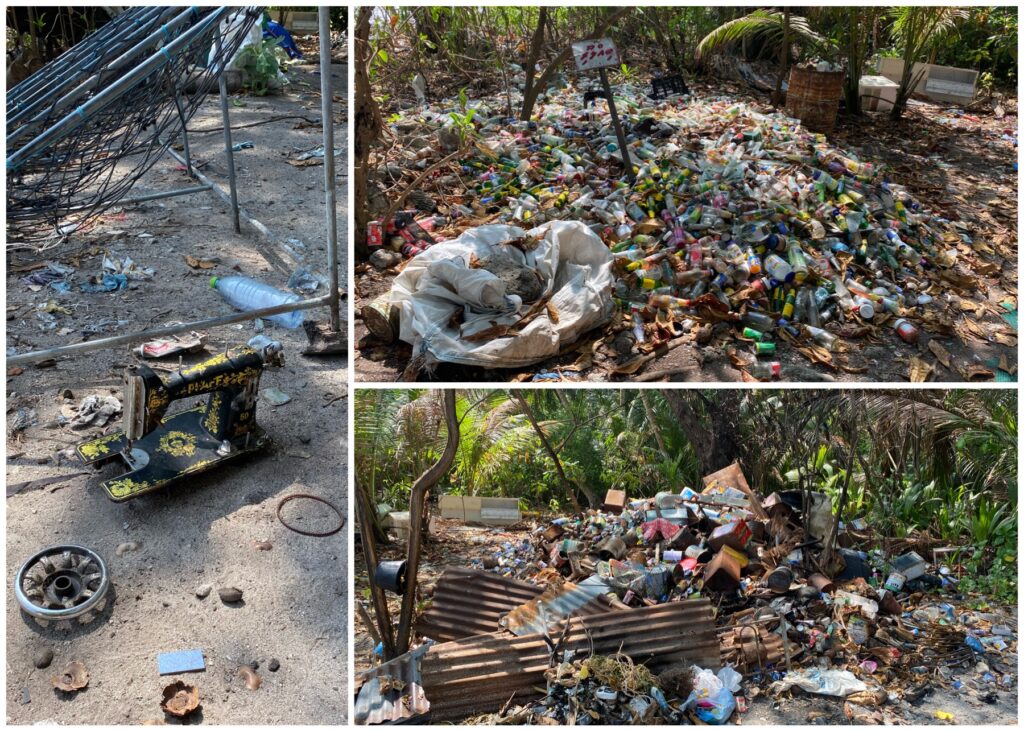
There had been plans to build a tourist resort on the south of the island and we wandered around some of the abandoned rooms. The company had gone bankrupt but Assad told us there are hopes that the resort will be completed at some future date. We wonder how a resort with westerners will fit with this small Muslim village.
It is incredibly hot and humid here during the day, with lots of mosquitoes in the evening, but the sea is lovely and warm. We’ve seen turtles in the anchorage who surface, lift their heads to take a breath or two and a look around, then dive again. There is also a pod of dolphins which regularly swims across the bay, and squid which float slowly in a long line under the boat most mornings.
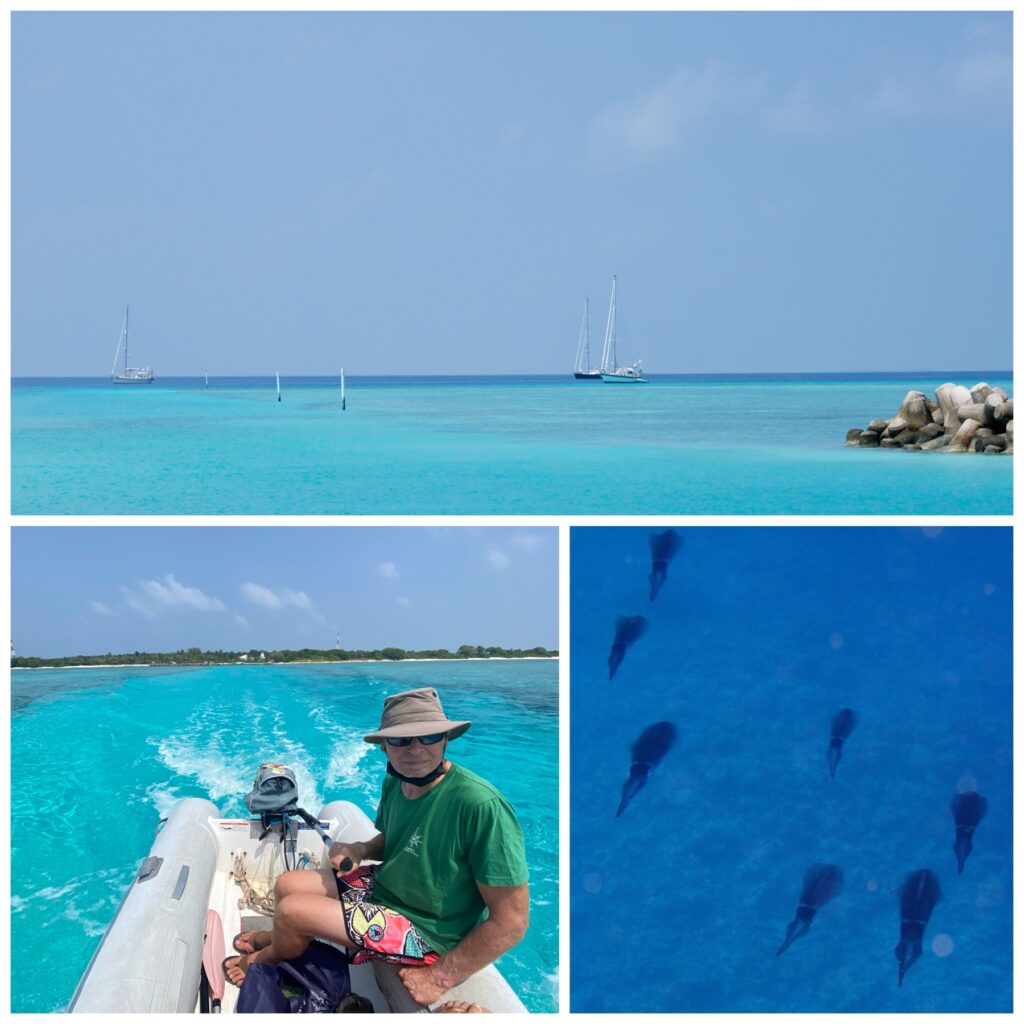
One afternoon we arrived at the boat harbour to find a group of fishermen gutting their catch. I asked if we could buy a small tuna from them and they gave me one for free, carefully filleted by them first. It was absolutely delicious fried in chilli – firm and fresh. After tourism, fishing is the next largest sector of the Maldives economy. Trawling is banned in the Maldives so it is all line fishing, mostly for tuna.
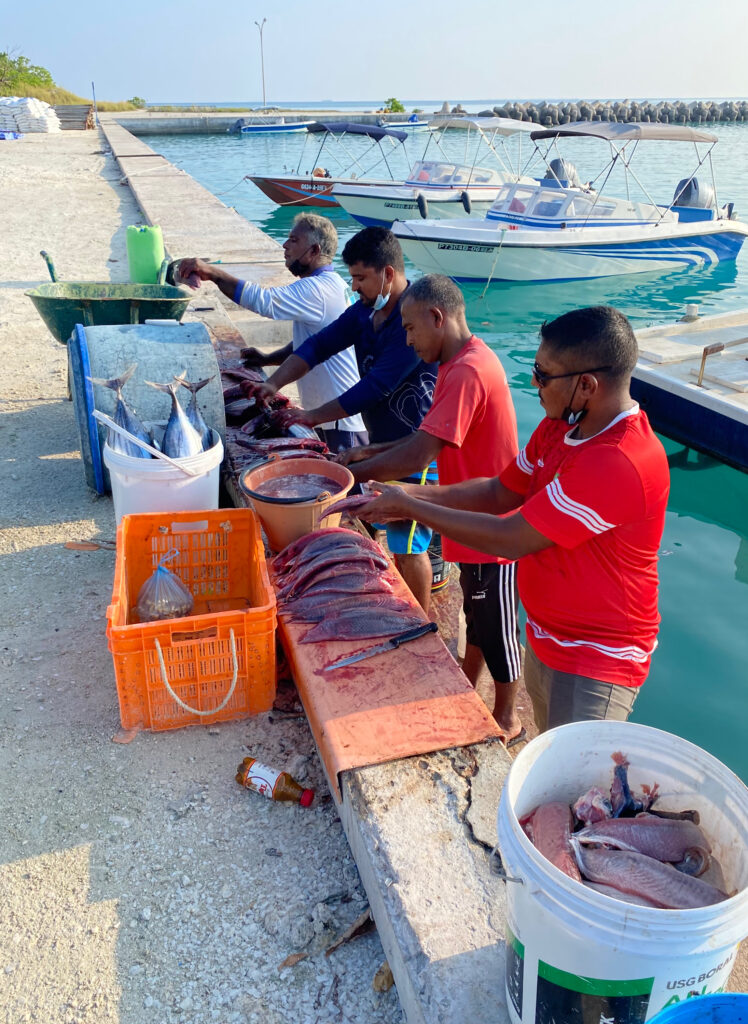
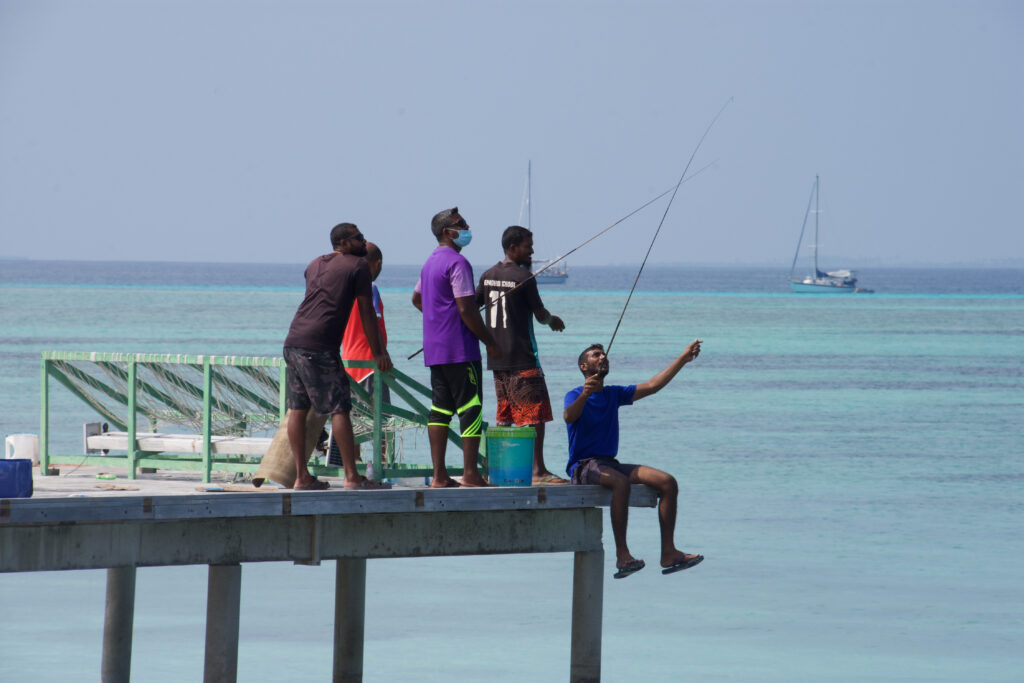
Two days after we arrived Russian troops entered Ukraine and, like most of the world, we watched in horror over the following days and weeks the terrible events unfolding there. We feel helpless as with every day there is yet more suffering and devastation. We watch the people resisting or fleeing and the moving speeches of President Zelensky.
Four days after us, Colin and Izzi sailed into the anchorage… their engine had cut out just before they arrived as they were so low on diesel the sludge in the bottom of the tank had blocked their fuel filters. Glad to be here at last they needed to sort out the problems with their watermaker and with their torn mainsail which had jammed in the mast on the way here.
It seems to us that we, Hecla and Endorphin Beta are the only boats cruising the Maldives this year, although Assad assures us that there are others, some of whom took part in a Maldives rally a month ago. The yachts which come and go as we are here in Uligan only stop for a few days en route to the Red Sea. We hear from friends on Golden Spirit, Talullah Ruby and Paw Paw, who left Thailand or Malaysia several weeks before us and stopped briefly in Uligan, that they have arrived safely in Djibouti.
In order to cruise the Maldives you need to employ an agent to obtain your cruising permit, and the person that we and most yachties seem to use is Asadhulla Mohammed (aka Assad) of Real SeaHawks. He seems to know everyone and is very relaxed about the whole process. We find it rather confusing. There are 1192 islands in the Maldives and on the whole these are either local islands, private tourist islands or uninhabited islands. Only 198 of the islands are inhabited. We understand that we can visit the uninhabited islands (if there’s a suitable spot to anchor in of course) and we can visit the few yacht-friendly resorts, and can visit the local islands if there is an airport on the island. The trouble for us is that most of the private resorts are exclusively for resort guests and they don’t want yachts anchored by them and a lot of scruffy, impecunious yachties visiting their luxury resorts, or they charge an arm and a leg for doing so. Neither do the local towns and villages necessarily want western visitors, so we will need to get the prior approval of Assad before we stop (so he can check with the local council that it’s acceptable and warn them that we’re coming).
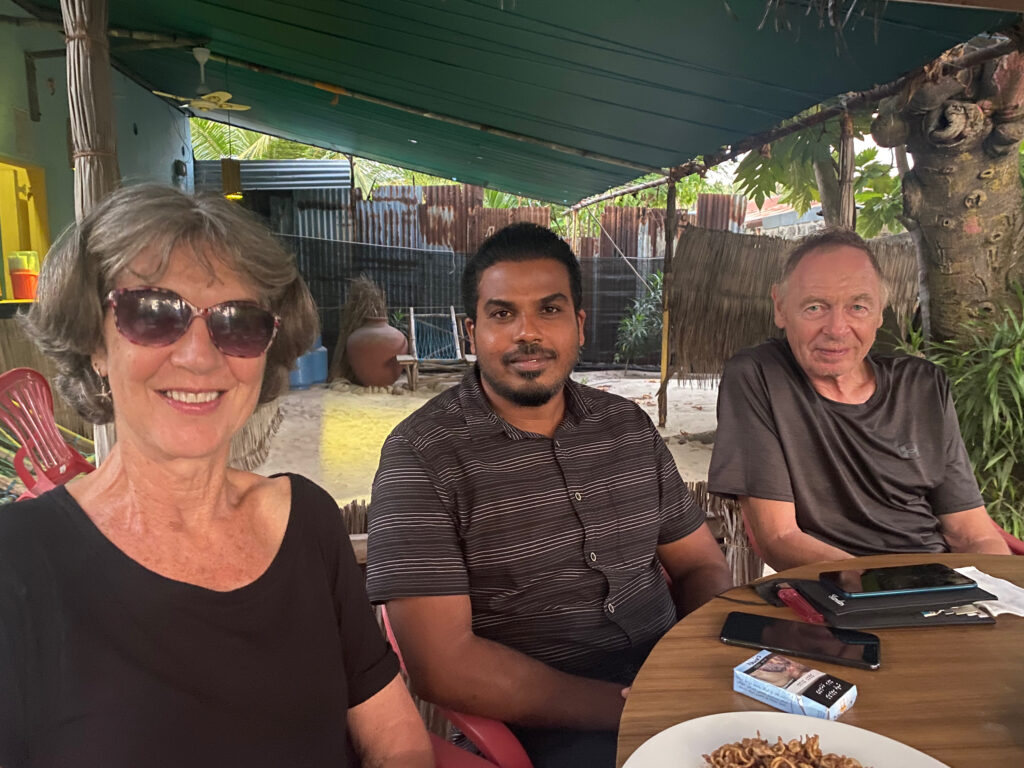
A few years ago the Maldives hugely increased the fees for visiting yachts and introduced a scheme in 2019 that cruising yachts would have to carry electronic tags so they could be monitored (and pay dearly for the privilege too). The yachts just stopped coming. Since then the fees have been reduced to a more reasonable amount and we are paying around US$950 for up to three months.
Two years ago a group of 16 yachts got stuck here in Uligamu as the borders of countries shut due to Covid. The Maldives closed its borders on 19th March 2020 and after that yachts were no longer allowed to enter the country. None of the yachties already here were allowed ashore, even to uninhabited islands, and initially they were restricted to their own boats, not allowed to socialise. Our Swedish friends on Rubicon arrived three days after lock-down and, although they were able to anchor, weren’t allowed to officially check into the country. They were isolated from the other boats who were, after a few weeks, allowed to mix with each other and to snorkel on the reef. All the countries around the Indian Ocean were closed so they had nowhere else to go. After 7 weeks in isolation, separated from the other 15 yachts, their every move watched by the coastguard, they were finally granted permission to stop at the French island of Reunion, 2000 miles away, and left. After 8 weeks at anchor here the other yachts were finally able to move on too.
After nine days in Uligan we were ready to move on. We had had our laundry done, refilled the tank and containers with diesel and run our water-maker several times. Endorphin Beta still had work to do which they didn’t need our help with, although Jon decided to stay on with them. We waited an extra day before leaving so we could stock up after the supply boat had visited, and managed to buy oranges, apples, banana, onions and garlic, potatoes and carrots, green beans and small capsicum. The following day we were up early and motored, on the windless morning, the 25 miles to the island of Dhapparu in the next atoll south.

2 Comments
Jetski
March 12, 2022 - 5:37 pmInteresting read about the Maldives, but most importantly so glad that Hugh is ok.
Paul
March 14, 2022 - 11:17 amVery glad Hugh is ok, it does look a fab place it would be a shame top spoil it with Hotels